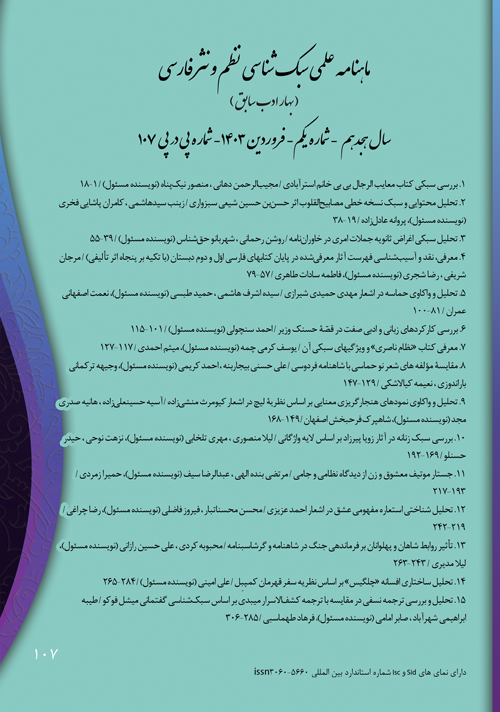- Count View : 213
- آدرس کوتاه شده مقاله: https://bahareadab.com/article_id/1797
- کد doi مقاله: Doi: 10.22034/bahareadab.2025 .18 .7676
Journal of the stylistic of Persian poem and prose
volume Number 18،
number In Volume 1،
،
issue Number 107
The impact of the relationship between kings and heroes on war command in the Shahnameh and Garshasbnameh
Mahboobe Kordi , Ali Hossein Razani (Author in Charge), Leila Modiri
Abstract
BACKGROUND AND OBJECTIVES: Epic literature describes heroic deeds, chivalry, chivalry, and sacrifice in the cause of the homeland. Kings and heroes are always two main and important elements in epic literature, which are especially influential in wars and their command. It seems that the type of relationship between kings and heroes can affect the command of war and bring it closer to failure or success. This article examines and compares the effect of the relationship between kings and heroes on the command of war in Ferdowsi"s Shahnameh and Asadi Tusi"s Garshasbnameh.
METHODOLOGY: The research data collection method is library and document-based, and the research method is analytical-descriptive; the statistical population is Ferdowsi"s Shahnameh and Asadi Tusi"s Garshaspnameh.
FINDINGS: The study of the relationship between kings and heroes in Shahnameh and Garshasbnameh shows that kings and heroes in these two epic works, according to the events and incidents that occur in the heart of the stories, experience various types of relationships, both interactive and confrontational, with each other, and this position is very effective in commanding wars. Based on the independent king and hero model, the people are the main commanders of the war who fight with their opponents (the unjust kings) and achieve victory. In fact, when the heroes and kings separate from each other, the people, in the form of the first heroes, take over the command of the wars, and it is obvious that these wars are of an internal and internal nature and are formed against the king of the land. It seems that the popular uprising and agitation gradually manifests itself in the form of heroes supporting the people, and this time the heroes fight the enemy not against the kings but alongside them, and this solidarity presents the most desirable command model.
CONCLUSION: The relationship between kings and heroes in these two epic works is diverse and varies according to time, place, and motivation, but the heroes always have a more moderate and adaptable face, and ultimately, it is these heroes who, in order to maintain unity and national interests, come to terms with the king and spend most of their strength and power on foreign wars and avoid civil wars over power. Command in these two works was different according to the capabilities of the heroes of each region, but a single method is reported throughout the work. If the king himself did not directly participate in the war, he chose one of the famous heroes to be the commander-in-chief of the army by writing a charter or giving the seal of command, which confirms the ideal model of the king and the hero together.
Keyword
Shahnameh
, Garshasbnameh
, Communication
, Heroes
, Shahs
, Command
- Asadi Toosi, Abu Nasr Ali. (1975). Garshasabnameh, by Habib Yaghmai, second edition, Tehran: Tahuri.
- Bahar, Mehrdad. (1998). From myth to history, by the effort of Abolqasem Esmailpour, Tehran: Asatir.
- Bahar, Mehrdad. (2007). A research in Iranian mythology, Tehran: Toos.
- Dinkard. (2016). By Fereydoun Fazilat, Tehran: Barsam.
- Dostkhah, Jalil. (2001). Iran's epic; A memory from beyond the millennia, Tehran: Agah.
- Ferdowsi, Abulqasem. (2000). Ferdowsi's Shahnameh, by Saeed Hamidian, 5th edition, Tehran: Qatre.
- Irvani, Mohammad Reza. (2021). "Conceptualization and presentation of the ideal command model in ancient Iran based on the narrative of Ferdowsi's Shahnameh with a focus on the narrative of the great battle of Key Khosrow with Afrasiab" Military Management Quarterly (1) 22, pp. 65-98.
- Lazar, Gilbert. (1978). "Pahlavi, Pahlavi in the Shahnameh", translated by Jale Amoozgar, Simorgh Magazine, number 5, pp. 47-61.
- Oshidari, Jahangir. (1992). Mazdyasna Encyclopedia, Zoroastrian Explanatory Dictionary, Tehran: Central Publishing.
- Rabi’ezadeh, Ali. (2014). "The place of Garshasab in Asadi Tusi's Garshasabname compared to Ferdowsi's Shahnameh and Pahlavi texts" of the first international historical congress of Shahid Beheshti University" ID code: 6148278997253556.
- Rastgar Fasaei, Mansour and Esna’ashari, Atlas. (2004). "Iranian identity in Persian literature until the Mongol invasion" Journal of Social and Human Sciences of Shiraz University, No. 42, pp. 69-80.
- Razmjo, Hossein. (2009). The Realm of Epic Literature, Vol. 2, Tehran: Research Institute of Humanities and Cultural Studies.
- Safa, Zabihullah. (1984). Epic writing in Iran, third edition, Tehran: Amir Kabir.
- Sarrami, Gadhamali. (2008). From the color of the flower to the pain of the thorn, the morphology of Shahnameh stories, Tehran: Scientific and Cultural.
- Shamisa, Siroos. (1997). The main plot of the story of Rostam and Esfandiar, Tehran: Mitra.
- Shamisa, Sirooss. (1994). Literary types, second edition, Tehran: Agah.
- Shariat, Zahra and Zaineli, Leila. (2009). "Epic, national and religious effects in Khavarannameh paintings" Shiraz School, Islamic Art Studies Magazine, Volume 5, Number 10, pp. 43-57.
- Talebian, Yahya and others. (2007). "The conflict between good and evil; The theme of Ferdowsi's Shahnameh and the archetype of narration", New Literary Essays, No. 158, pp. 101-106.
- Zarqani, Seyed Mahdi. (1998). "Relationships between kings and warriors in Ferdowsi's Shahnameh", Keyhan Farhangi, No. 149, pp. 16-20.
- Zomorrodi, Homeyra. (2007). Plant symbols and symbols in Persian poetry, Tehran: Zavvar.

